The Intel SSD DC P3700 series of SSDs is Intel’s latest NVMe SSD designed for mainstream applications and storage system providers. The P3700 comes in both a 2.5″ and PCIe add-in card form factors and capacities up to 2TB. At the top end, the P3700 delivers up to 2,800MB/s sequential read, 2,000MB/s sequential write and 450,000 random 4K read IOPS. Beyond the hero numbers though, Intel is specifically targeting predictability in performance with the P3700, understanding that consistency of IOPS is as important as top-end performance.
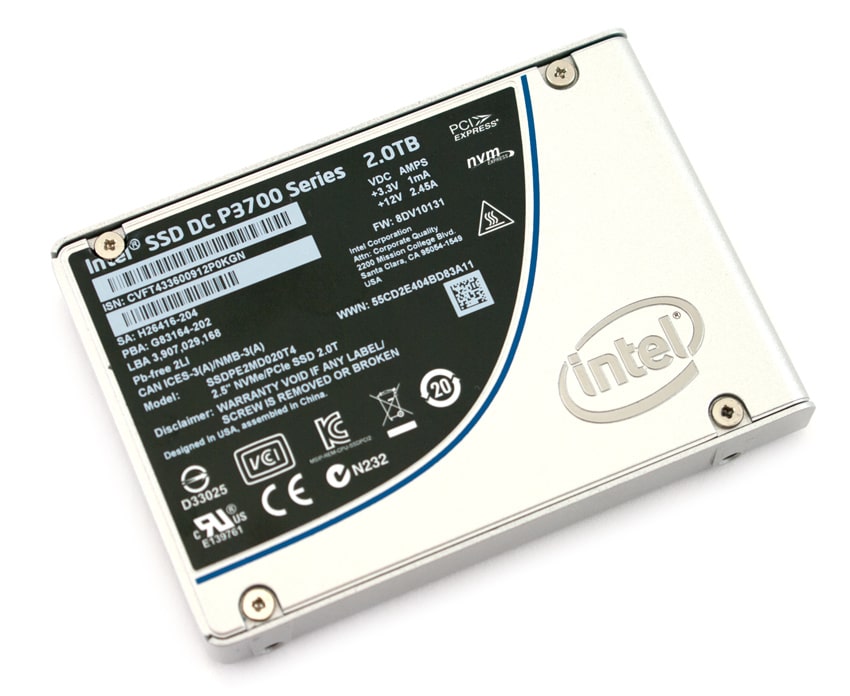
The P3700 drives are vertically integrated solutions from Intel; they produce the controller, NAND (20nm MLC) and firmware. This gives Intel better insight into the drive’s characteristics and makes support and future enhancements more streamlined. Intel includes driver support for most modern operating systems and the drive is rated for 17 drive writes per day over its five-year warranty.
The P3700 is part of Intel’s broad line of enterprise SSDs. The biggest differentiators between it and the P3500 and P3600 are largely around endurance. While the P3700 does get a modest boost in throughput from the P3500 and P3600, latency remains the same across the three drives. The P3700 as notes however delivers on an endurance quote of up to 17 DWPD, where the P3500 and P3600 offer .3 and 3 DWPD respectively. Intel also offers the P3608, which is more or less two P3600s on an add-in card that doubles capacity (4TB) and performance (5000MB/s) of a single P3600 SSD.
Our review is of the 2TB capacity in 2.5″ form factor.
Intel SSD DC P3700 NVMe SSD Specifications
- Series Name: Intel SSD DC P3700 Series
- Capacities: 400GB, 800GB, 1.6TB, 2TB
- Sequential Read: Up to 2800
- Sustained Write: Up to 2000
- Performance (MB/s)
- Read: Up to 460
- Write: Up to 175
- Random I/O Read
- Operations Write (70/30 Read/Write per Second 4KB K-IOPS): Up to 265
- Lifetime Endurance: 17 Drive Writes Per Day
- Latency Read/Write: 20µs / 20µs
- Interface: Non-Volatile Memory express (NVMe*) PCIe* 3.0 x4
- Form Factor Height / Weight:
- 2.5-inch : 15mm/up to 125 grams
- AIC: Half Height Half Length (HHHL) /195 grams
- Life Expectancy: 2 million hours Mean Time Between Failures (MTBF), 230 years
- Power Consumption
- Active: <25W (Write) / <11W (Read)
- Idle: 4W Typical
- NAND Flash Memory: Intel NAND Flash Memory Multi-Level Cell (MLC) 20nm
- Operating Temperature:
- 2.5-inch FF: 0° C to 35° C ambient temperature with suggested airflow, 0° to 70° C case temperature
- AIC: 0° C to 55° C ambient temperature with suggested airflow
- RoHS Compliance: Meets the requirements of European Union (EU) RoHS Compliance Directives
- Software Support: Intel® Solid-State Drive Data Center Tool
Design and build
The Intel DC P3700 is an NVMe SSD that has a 2.5” form factor with a 15mm Z-height. It is thicker than other SSDs but it will still fit within most arrays as many are designed to house 3.5” HDDs as well as the thicker 2.5” HDDs. The outer housing is brushed metal with a sticker on top with information such as serial/model numbers. The opposite corner has Intel branding. There are four screws on top to take the outer housing off.
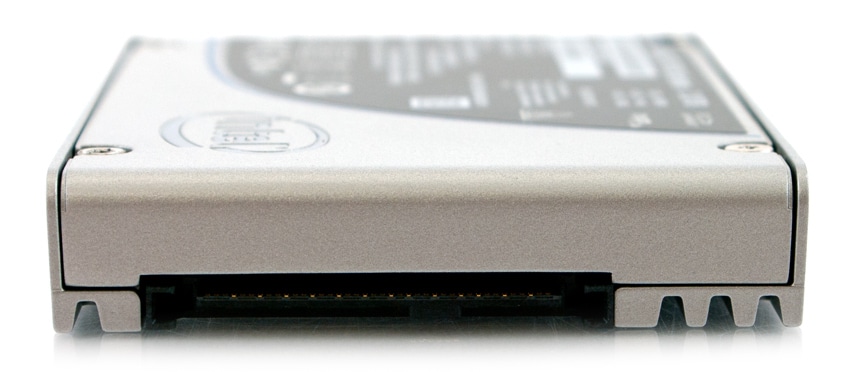
The sides of the drive have four holes for mounting (2 on each side).
The Bottom of the drive has grooves running across the entire surface for heat dissipation. There are 4 holes for mounting. On the bottom one can also see the PCIe interface that though it looks similar to a SAS interface, it does enable much higher performance.
Inside drive it has dual PCB boards with Intel 20nm MLC NAND and an Intel NVMe controller.
Testing Background and Comparables
The StorageReview Enterprise Test Lab provides a flexible architecture for conducting benchmarks of enterprise storage devices in an environment comparable to what administrators encounter in real deployments. The Enterprise Test Lab incorporates a variety of servers, networking, power conditioning, and other network infrastructure that allows our staff to establish real-world conditions to accurately gauge performance during our reviews.
We incorporate these details about the lab environment and protocols into reviews so that IT professionals and those responsible for storage acquisition can understand the conditions under which we have achieved the following results. None of our reviews are paid for or overseen by the manufacturer of equipment we are testing. Additional details about the StorageReview Enterprise Test Lab and an overview of its networking capabilities are available on those respective pages.
We tested the Intel SSD DC P3700 inside the SuperMicro SuperServer 2028U-TNR4T+ system, while comparing it to the following other NVMe SSDs:
- Samsung XS1715 Enterprise NVMe SSD
- Memblaze PBlaze 4 SSD
Application Workload Analysis
In order to understand the performance characteristics of enterprise storage devices, it is essential to model the infrastructure and the application workloads found in live production environments. Our first benchmarks for the Intel SSD DC P3700 are therefore the MySQL OLTP performance via SysBench and Microsoft SQL Server OLTP performance with a simulated TCP-C workload. For our application workloads each drive will be running 2-4 identically configured VMs.
StorageReview’s Microsoft SQL Server OLTP testing protocol employs the current draft of the Transaction Processing Performance Council Benchmark C (TPC-C), an online transaction processing benchmark that simulates the activities found in complex application environments. The TPC-C benchmark comes closer than synthetic performance benchmarks to gauging the performance strengths and bottlenecks of storage infrastructure in database environments. Each instance of our SQL Server VM for this review uses a 333GB (1,500 scale) SQL Server database and measures the transactional performance and latency under a load of 15,000 virtual users.
When looking at SQL Server Output, the Intel drive had the highest throughput of an individual VM with 3,157.469 TPS; however, the XS1715 was within 0.1 in TPS. The Intel drive had a leading aggregate of 3,157.341 TPS.
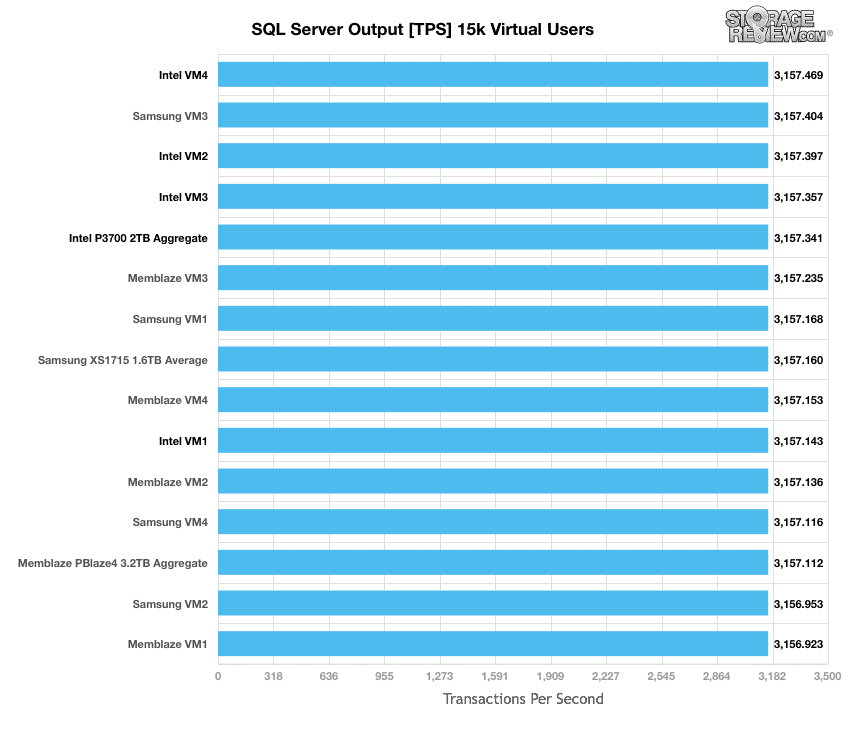
Looking at average latency results during the 15k user SQL Server benchmark showed the Intel drive at the top of the pack with 7ms with an aggregate of 7ms as well. Results were identical with the Samsung SSD while the Memblaze drive had an aggregate of 7.5ms.
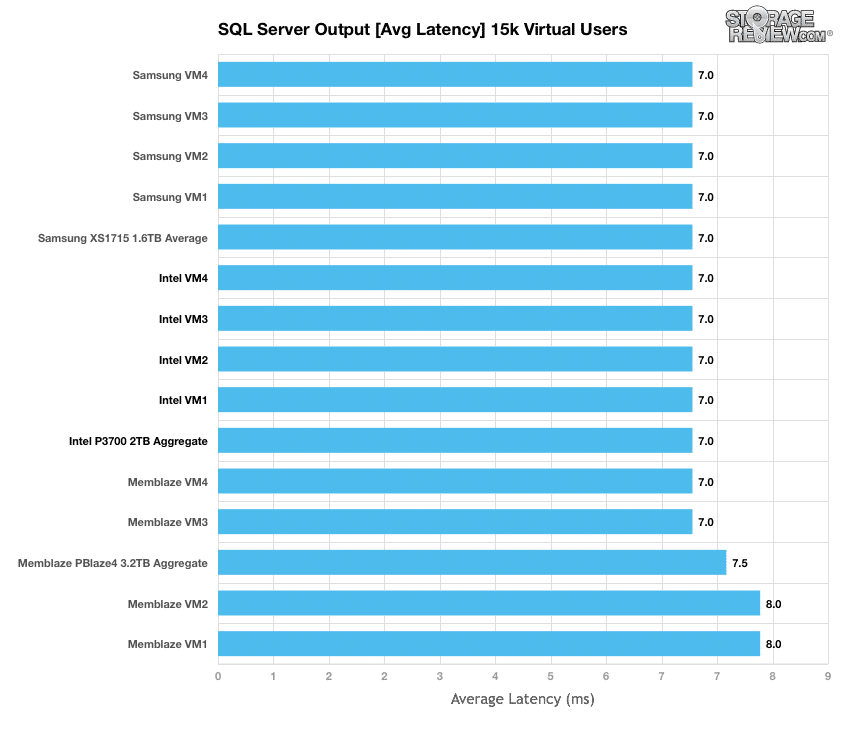
The next application benchmark consists of a Percona MySQL OLTP database measured via SysBench. This test measures average TPS (Transactions Per Second), average latency, as well as average 99th percentile latency. Percona and MariaDB are using the Fusion-io flash-aware application APIs in the most recent releases of their databases, although for the purposes of this comparison we test each device in their “legacy” block-storage modes.
In the average transactions per second benchmark, the Intel SSD DC P3700 showed the best performance with 5,779.7 TPS aggregate, slightly edging out the Memblaze drive that had an individual VM hit 5,717.2 TPS.
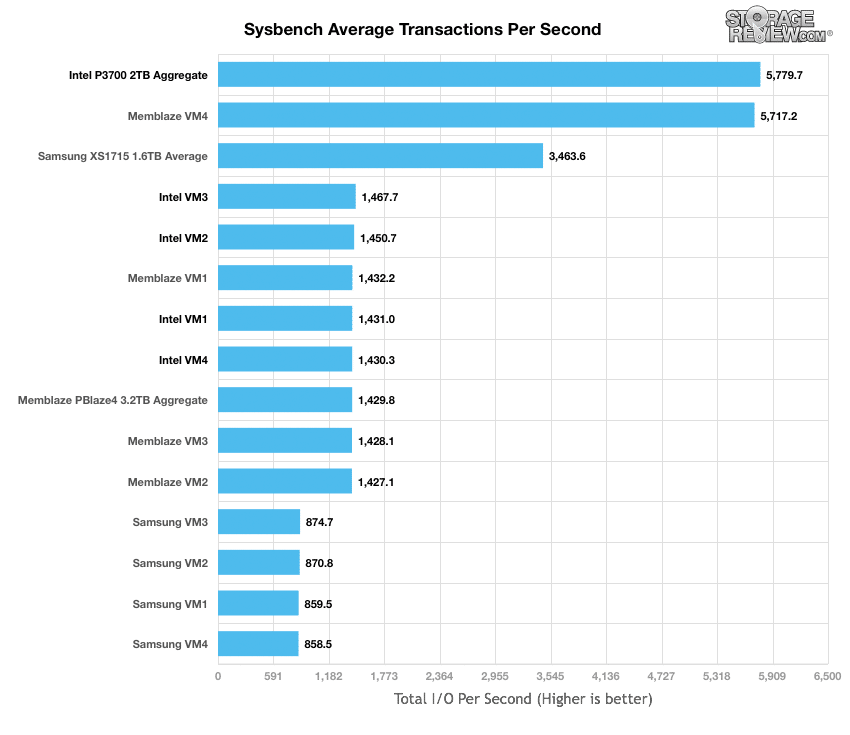
Average latency results were more of the same with the Intel drive ranking at the top of the leaderboard with 22.15ms aggregate. The Memblaze was the next best performer with individual VMs running between 22.34ms through 22.42ms and aggregate latency of 22.38ms.
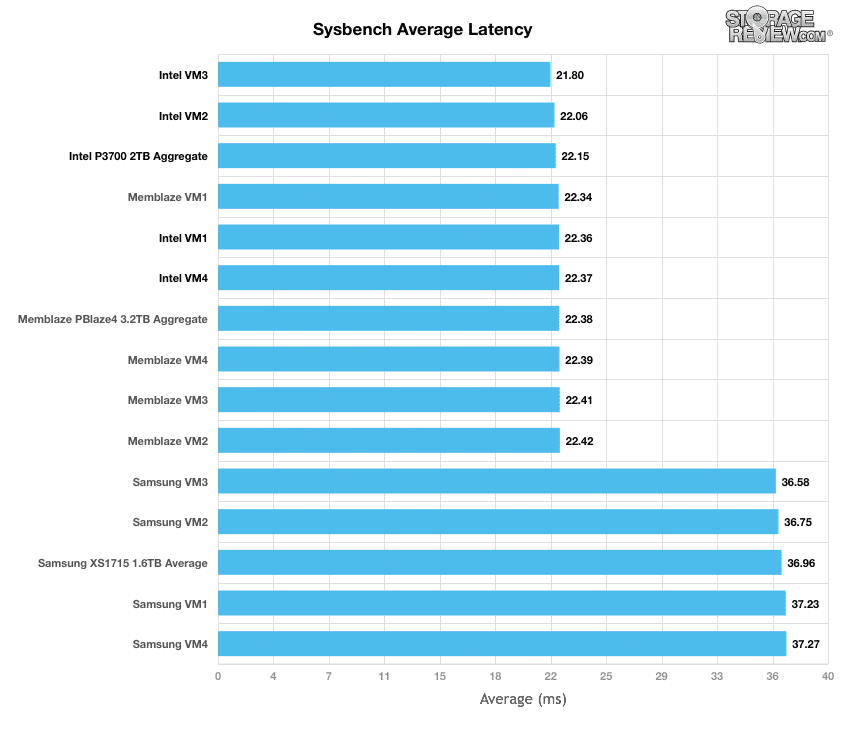
In terms of our worst-case MySQL latency scenario (99th percentile latency), the Intel drive boasted an impressive aggregate of just 45.97ms while the Memblaze showed VMs running between 58.03ms and 58.00ms.
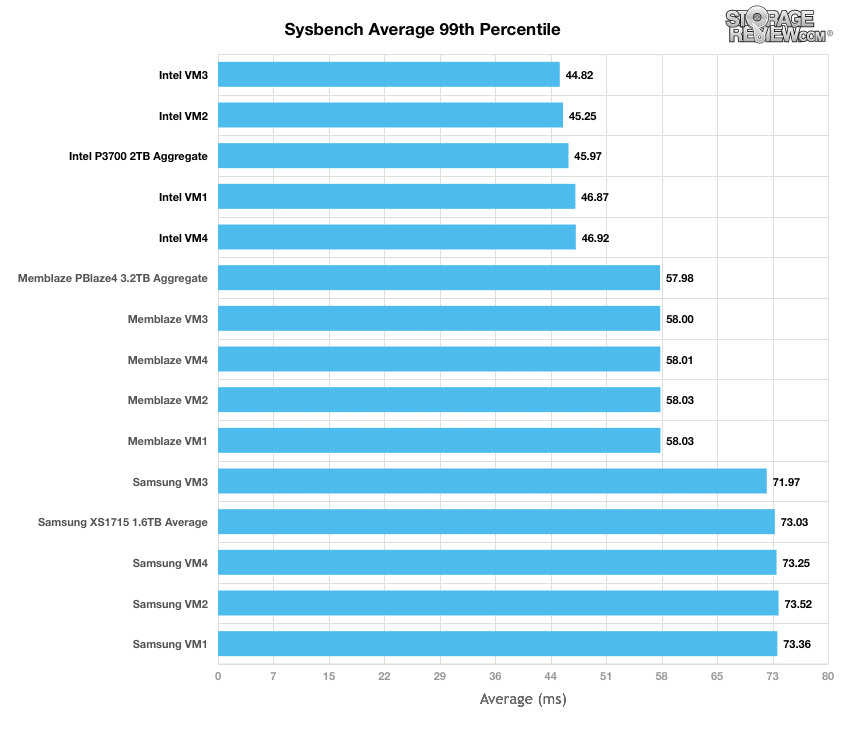
Enterprise Synthetic Workload Analysis
Flash performance varies as the drive becomes conditioned to its workload, meaning that flash storage must be preconditioned before each of the fio synthetic benchmarks in order to ensure that the benchmarks are accurate. Each of the comparable drives are preconditioned into steady-state with a heavy load of 16 threads and an outstanding queue of 16 per thread.
Preconditioning and Primary Steady-State Tests:
- Throughput (Read+Write IOPS Aggregate)
- Average Latency (Read+Write Latency Averaged Together)
- Max Latency (Peak Read or Write Latency)
- Latency Standard Deviation (Read+Write Standard Deviation Averaged Together)
Once preconditioning is complete, each device is then tested in intervals across multiple thread/queue depth profiles to show performance under light and heavy usage. Our synthetic workload analysis for the Intel SSD DC P3700 uses two profiles, which are widely used in manufacturer specifications and benchmarks. It is important to take into consideration that synthetic workloads will never 100% represent the activity seen in production workloads, and in some ways inaccurately portray a drive in scenarios that wouldn’t occur in the real world.
- 4k
- 100% Read and 100% Write
- 8k
- 70% Read/30% Write
In our throughput 4k write preconditioning test, the Intel P3700 was the top performer as it began roughly at 400,000 IOPS and hitting a steady-state just under 170,000 IOPS. The Samsung XS1715 showed burst results just behind the Intel drive, though it fell to last place and behind the much more consistent Memblaze.
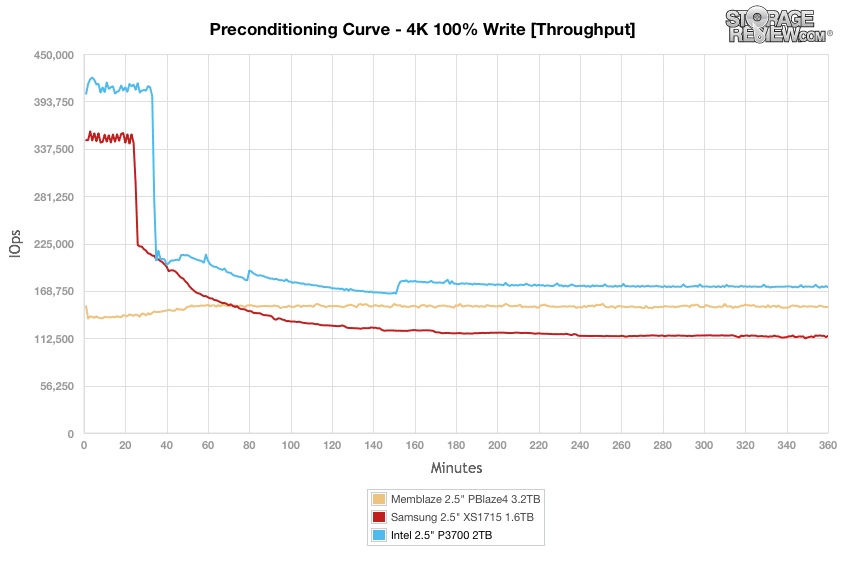
Next we look at average latency, where both the Intel and Samsung drives started around the 0.6ms mark and spiking somewhere after 20 minutes. The Intel drive remained the most stable of the two for the remainder of the test, taking top spot. The Memblaze, however, was the most consistent drive latency-wise.
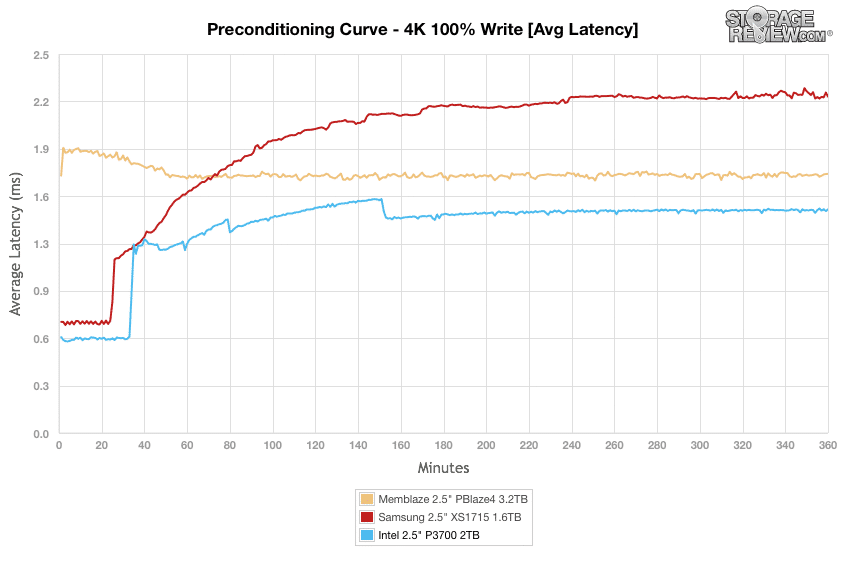
Measuring max latency showed the Intel SSD as the most stable drive by a noticeable margin, hovering around the 25ms latency mark throughout the test and without any major spikes. The Samsung and particularly the Memblaze had major spikes during our max latency readings.
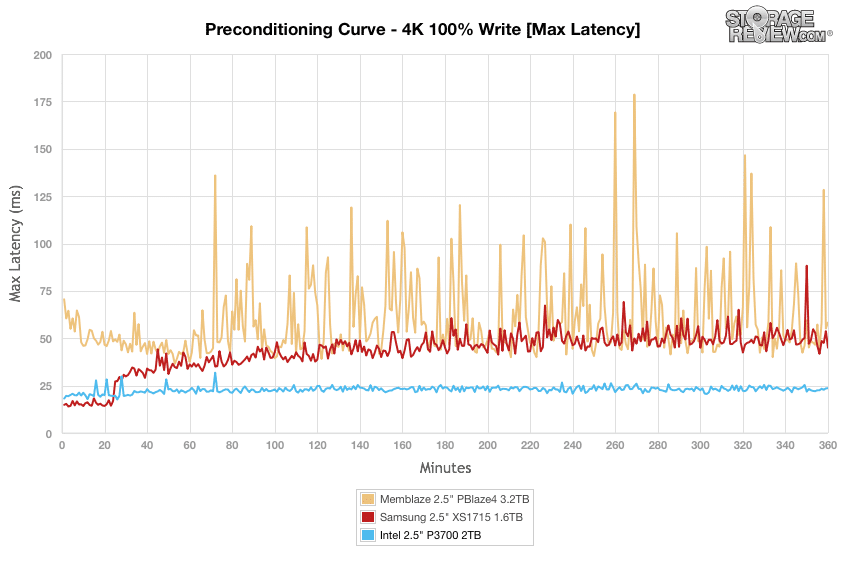
Standard deviation calculations is designed make it easier visualize the consistency of the SSD latency performance results. In this scenario, the Intel drive started out strong, though it showed a significant spike in latency around the 22 minute mark. It remained fairly stable afterwards, taking top spot and just under 1.5ms by the end.
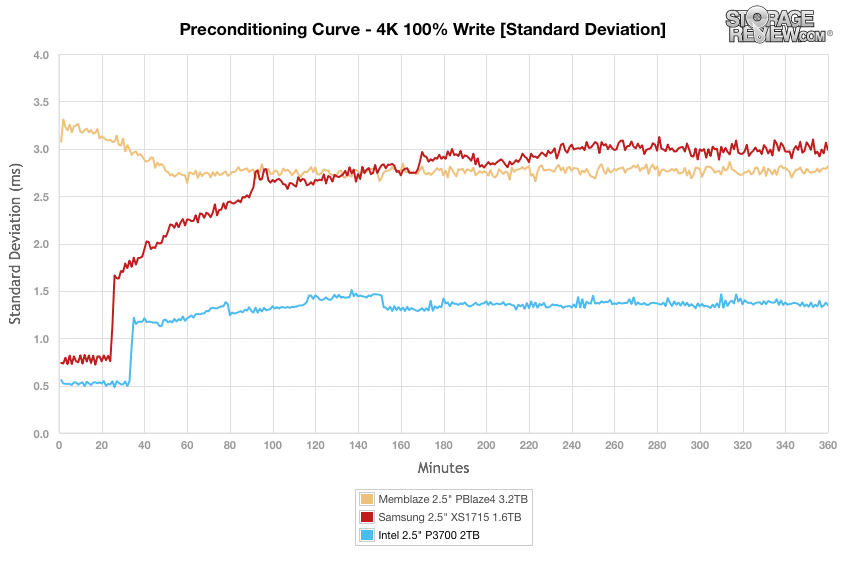
During the primary 4k synthetic benchmark, the Memblaze drive was by the top performer by far in the read column with an impressive 717,172 IOPS while the Intel drive showed the best write performance with 172,672 IOPS.
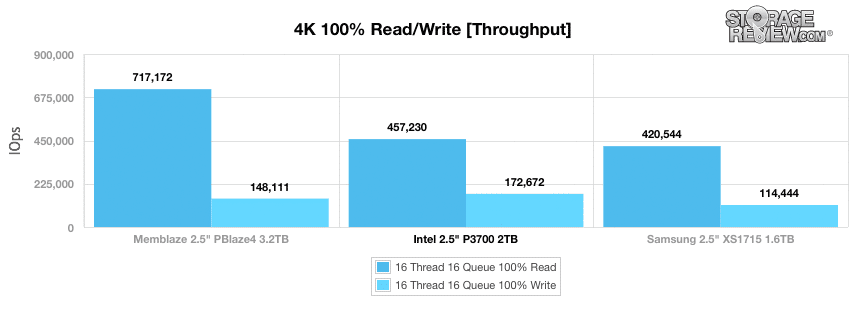
Results were more or less of the same when looking at average latency, as the Intel drive showed 0.56ms read and 1.48ms write, placing it just behind the Memblaze drive.
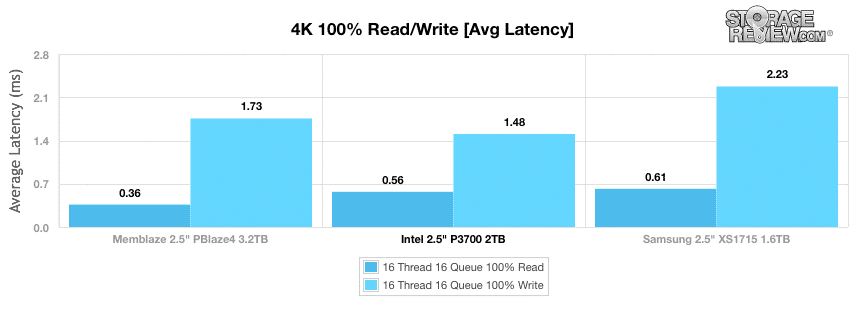
In max latency, the Intel P3700 boasted the top performance in writes with just 33.1ms, while top max read latency was held by the Samsung, which recorded 5.8ms.
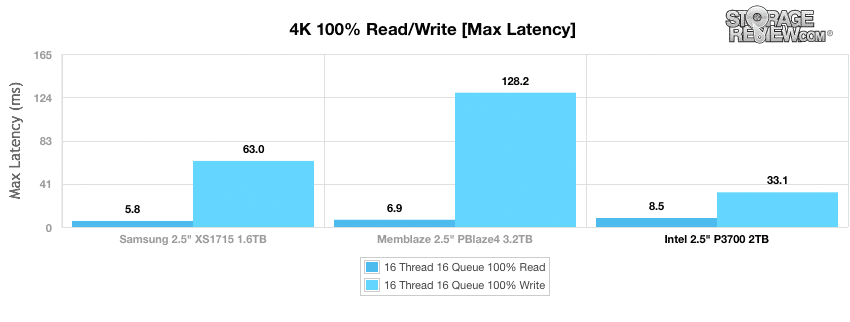
Results were mirrored when looking at standard deviation with the Intel drive leading in write latency again with 1.377ms. The Samsung XS1715 showed the top read latency with 0.08ms.
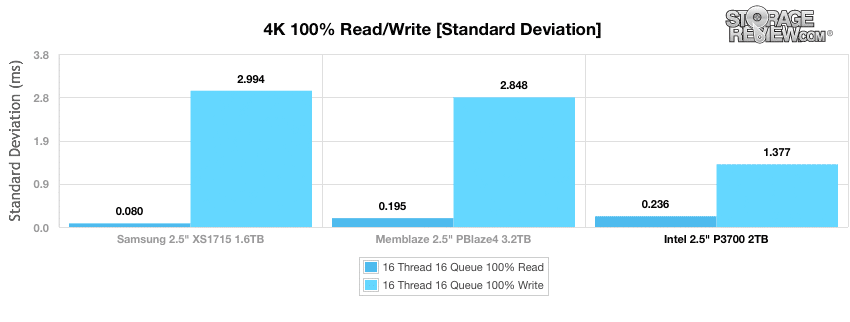
Our next workload uses 8k transfers with a ratio of 70% read operations and 30% write operations. Again, we will start off with the preconditioning results before switching to the main tests. In throughput, the Intel drive showed top performance at beginning of the test by a significant margin, ending up with a steady-state of roughly 176,000 IOPS for second place.
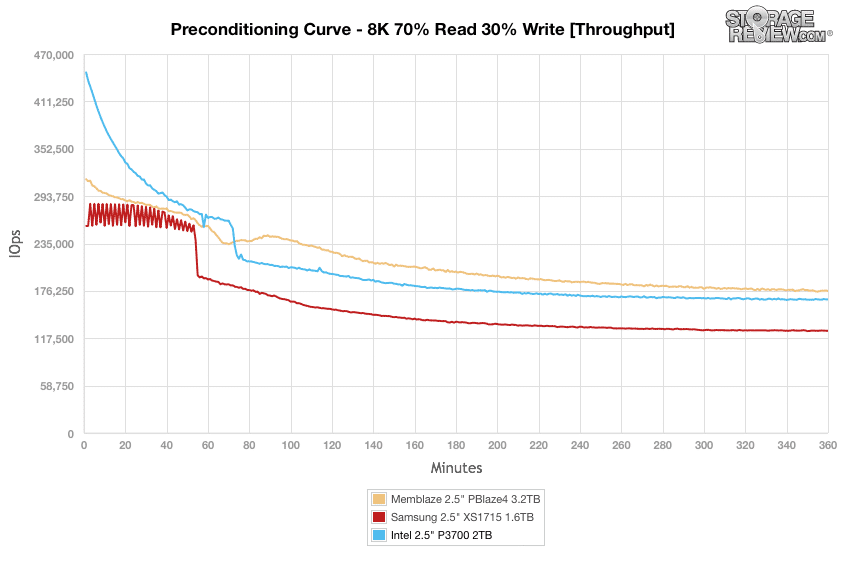
Average latency told a similar story, with the Intel drive showing the best performance at the beginning of the test, only to show a large spike around the 70 minute mark. By the end, it reached a steady-state around 1.6ms for second place again.
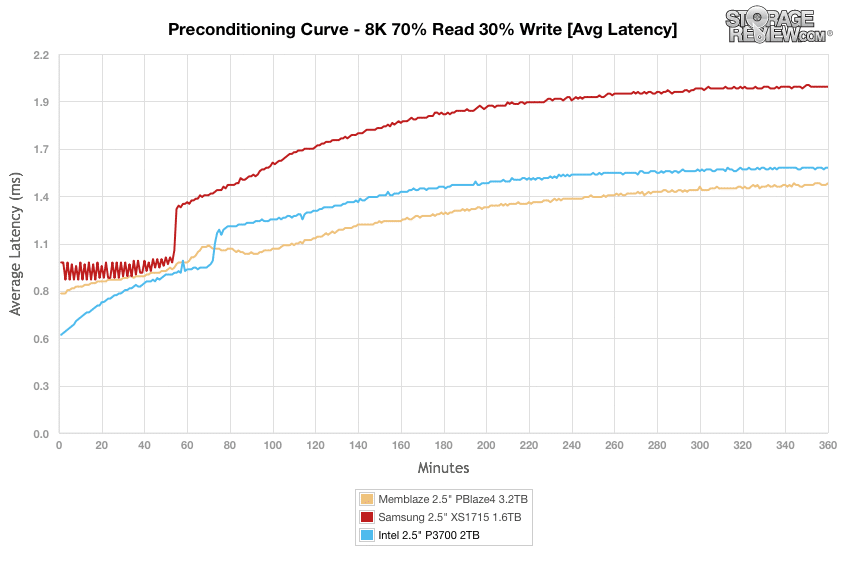
When looking at max latency, the Intel drive was by far the best performing drive, showing a somewhat consistent latency throughout. The Memblaze drive posted very inconsistent latency, posting huge spikes during the entire benchmark.
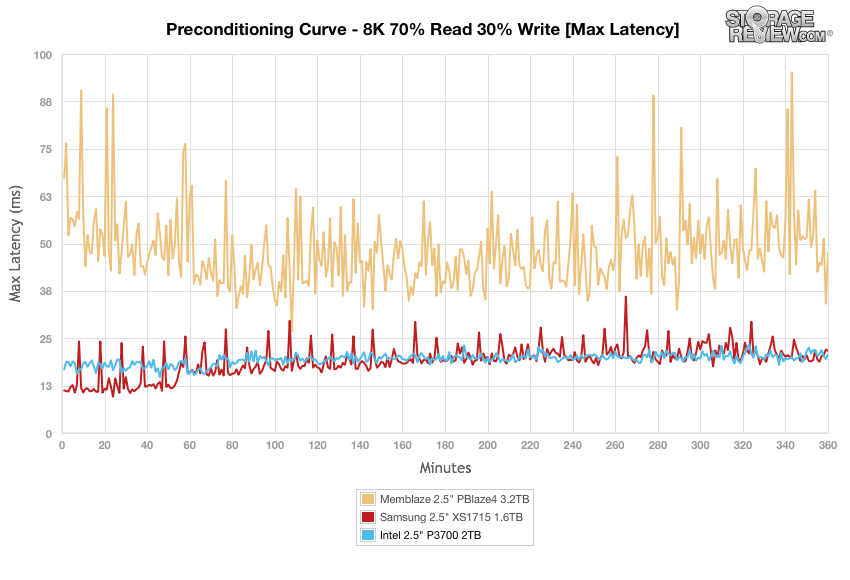
Standard deviation showed latency all over the place for all drives during the first portion of the test. Again, the Intel P3700 showed the best results, as it only peaked over the 1.2ms on a handful of occasions.
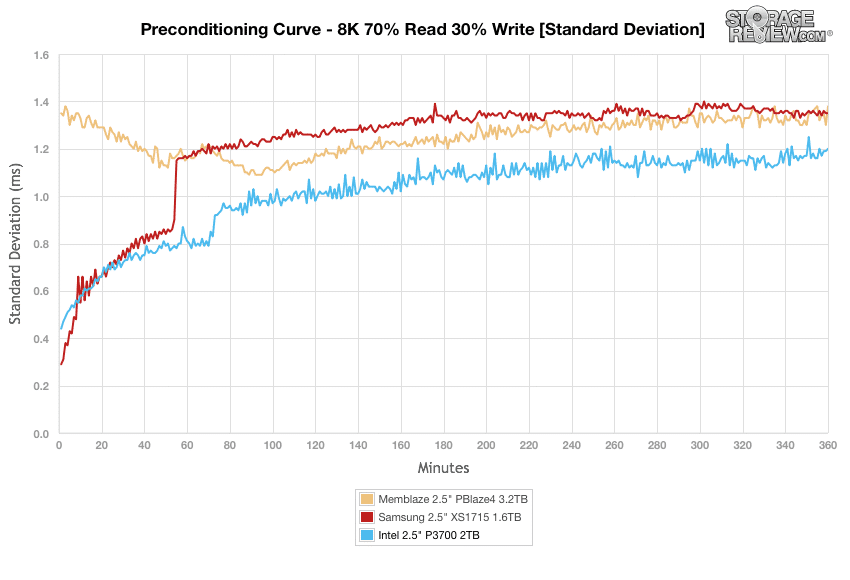
After we fully preconditioned the Intel P3700 drive, we put it through our main 8k 70/30 test. In throughput, the Intel drive showed the best throughput throughout the entire test up until the very end, where the Memblaze pulled away at the last queue depth surpassing 166,250 IOPS.
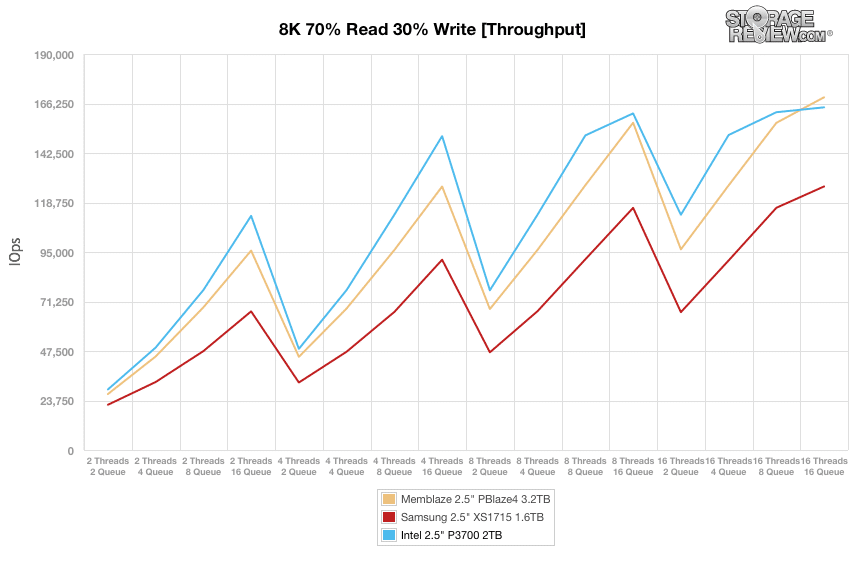
Average latency results showed similar results, with the Intel and Memblaze drives neck and neck to until the very even, where the latter pulled away once again in the terminal. The Intel drive started at roughly 0.2ms.
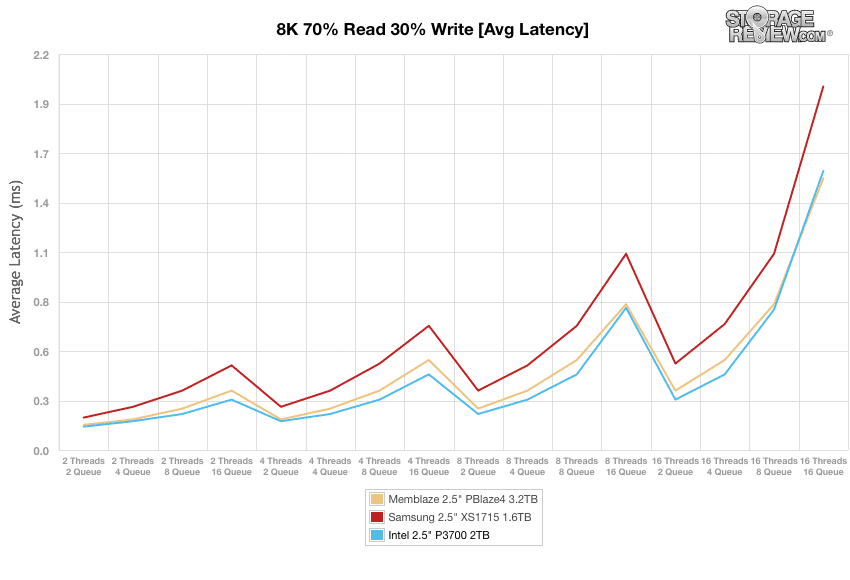
Looking at max latency showed the Intel drive with the best overall results, as it only passed the 20ms mark on a few occasions. The Samsun XS1715, however, boasted the most consistent results as it had the least amount of latency spikes.
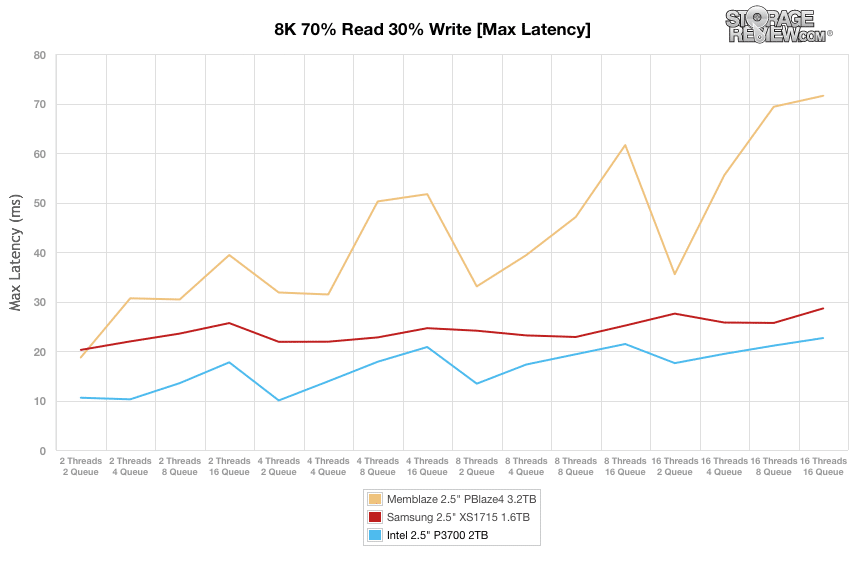
Standard deviation results demonstrated neck and neck performance between the Intel and Memblaze drives, all the way to the terminal queue depths. Overall, however, the Intel drive posted the best overall results with a range of 0.2ms to just 1.15ms.
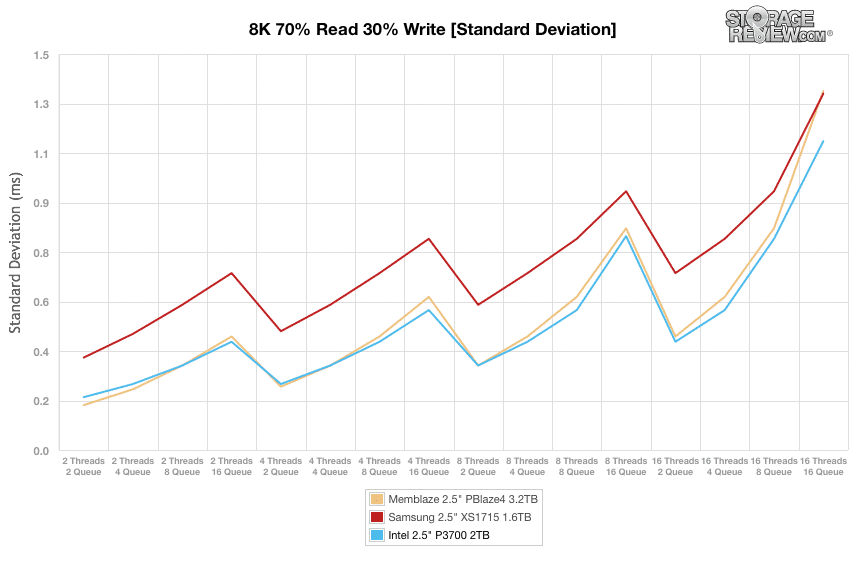
Conclusion
Available in capacities up to 2TB, the Intel P3700 is at the top drive of the family, which is designed for both mainstream applications and storage system providers. Intel has certainly introduced their new family of NVMe enterprise drives in a massive way with three different lines and two different form factors (2.5″ and PCIe add-in card) that span a grand total of 12 different capacities. There aren’t many companies (besides the big three) that can afford such an impressive launch. The P3700 drives and their family are also vertically integrated solutions, meaning the Intel produces the controller, NAND (20nm MLC) and firmware (Intel also provides driver support for operating systems). This allows Intel to better understand the drive’s characteristics, allowing them to effectively support their drive and offer more streamlined enhancements in the future.
When looking at performance, it’s obvious that the Intel DC P3700 is a power-house performer, as it lead in quite a few of our tested workloads. That said, we pitted it against the Samsung XS1715 1.6TB and Memblaze PBlaze4 3.2TB NVMe SSDs. In our SQL Server test, the Intel drive had the highest throughput boasting an impressive 3,157.5 TPS as well as leading aggregate of 3,157.341 TPS. In addition, the Intel drive shared the lead with the Samsung XS1715 in average latency, showing 7.0ms. In our Sysbench tests, we saw impressive performance once again with a top TPS of 5,779.7, an aggregate average latency of 22.15ms, and a worst case (99th percentile) aggregate result of 45.97ms.
During our main Synthetic benchmarks, the Intel DC P3700 posted a 4k throughput of 457,230 IOPS read and a top write performance of 172,672 IOPS. In average latency, the Intel drive posted 0.56ms read and leading 1.48ms write while leading boasting max latency/standard deviation read performance of 8.5ms read and 0.236ms, respectively. Things picked up significantly for the Intel DC P3700 in our 8k 70/30 workload, as the drive recorded performance at near the top of the leaderboard in all categories.
Pros
- Good performance across all workloads
- Most consistent performance overall
Cons
- Tops out at 2TB of capacity
Bottom Line
The Intel SSD DC P3700 NVMe SSD delivers tremendous performance that also remains predictable making it an ideal choice for most data centers.
Discuss this review




 Amazon
Amazon